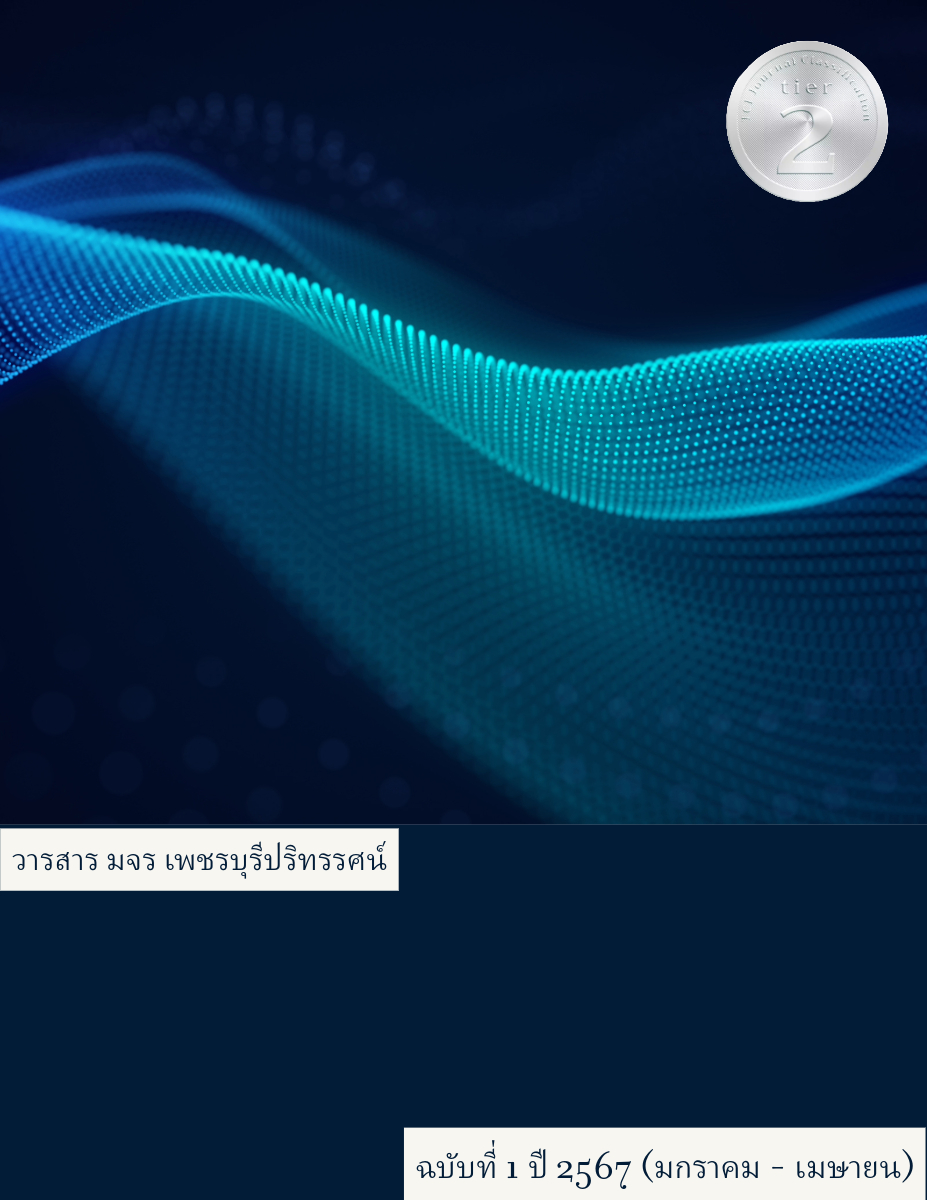INTERNAL QUALITY ASSURANCE OF SCHOOLS ACCORDING TO SCHOOL STANDARDS IN SAHAMIT WITAYA EDUCATIONAL QUALITY DEVELOPMENT CENTER UNDER CHIANG MAI PRIMARY EDUCATIONAL SERVICE AREA OFFICE 3
Main Article Content
Abstract
Research on internal quality assurance of schools according to school standards in Sahamit Witaya Educational Quality Development Center under Chiang Mai Primary Educational Service Area Office 3 aimed to study the implementation and development of internal quality assurance of schools according to school standards in Sahamit Witaya Educational Quality Development Center under Chiang Mai Primary Educational Service Area Office 3. The populations were administrators, teachers, and educational personnel of the schools in the Samit Rawitthaya Educational Quality Development Center under under Chiang Mai Primary Educational Service Area Office 3, in the academic year 2023, total number of 141 people and 6 experts in an interview, selected by the specific method. The research tools were questionnaires and interview forms. The statistics used in the data analysis were the percentage, mean, standard deviation, and content analysis and then descriptive presentation. The results revealed that the internal quality assurance of schools according to school standards in Sahamit Witaya Educational Quality Development Center under Chiang Mai Primary Educational Service Area Office 3, administrators and teachers performed the internal quality assurance of schools according to school standards in Sahamit Witaya Educational Quality Development Center under Chiang Mai Primary Educational Service Area Office 3 in overall, was at a high level. When considering each aspects were found to be at a high level, in descending order of average values, as follows: self-assessment performance reports, performance monitoring to improve the school's quality in accordance with educational standards, development plans for school's education management that focuses on quality in accordance with educational standards, evaluation and monitoring the internal quality of education of the school, the school quality development regularly, the application of the quality assessment results and recommendations and the highest level was the educational standards setting of the school and the implementation of the educational management plan of the school.
Article Details

This work is licensed under a Creative Commons Attribution-NonCommercial-NoDerivatives 4.0 International License.
References
กานต์ธีรา ภูริวิกรัย. (2564). การขับเคลื่อนเป้าหมายการพัฒนาอย่างยั่งยืนของประเทศไทย. มจร.บาฬีศึกษาพุทธโฆสปริทรรศน์, 7(3), 57-65.
จิราภรณ์ พรมสืบ. (2559). การศึกษาผลสัมฤทธิ์ทางการเรียนและความพึงพอใจของนักเรียนชั้นมัธยมศึกษาปีที่ 1 ด้วยการจัดกิจกรรมการเรียนรู้แบบร่วมมือโดยใช้เทคนิคแบ่งกลุ่มคละผลสัมฤทธิ์ รายวิชาวิทยาศาสตร์ หน่วยการเรียนรู้ เรื่อง สารละลายกรดและเบส . วิทยานิพนธ์ วท.ม. ชลบุรี: มหาวิทยาลัยบูรพา.
จุไรรัตน์ อนันต์ไพรฑูรย์. (2563). การพัฒนาทักษะการทำงานเป็นทีมในรายวิชางานอาหาร โดยใช้การจัดการเรียนรู้แบบร่วมมือของนักเรียนชั้นมัธยมศึกษาปีที่ 2. เข้าถึงได้จาก เข้าถึงจาก Rsuir Library: https://rsuir-library.rsu.ac.th/handle/123456789/541
ชาตรี ฝ่ายคำตา. (2559). ประเด็นและแนวโน้มการวิจัยทางวิทยาศาสตร์ศึกษา. วารสารหน่วยวิจัยวิทยาศาสตร์ เทคโนโลยี และสิ่งแวดล้อมเพื่อการเรียนรู้, 7(1), 163-178.
เดชวัตร ตติยเกียรติถาวร. (2563). ประสิทธิผลการสอนเรื่อง เชื้อเพลิงและซากดึกดำบรรพ์ ด้วยเทคนิคการสอนแบบแก้ปัญหา (Problem Solving Method) ของนักเรียนระดับชั้นมัธยมศึกษาปีที่ 6 โรงเรียนวัดคิรีวิหาร(สมเด็จพระวันรัต อุปถัมภ์) ภาคเรียนที่ 1 ปีการศึกษา 2563. เข้าถึงได้จาก https://www.kiree.ac.th/super/modules/adviser/file_upload/23010002/104/104_1041602528957.pdf
ดวงใจ สีเขียว. (2560). ผลการจัดการเรียนรู้แบบใช้ปัญหาเป็นฐานร่วมกับการจัดการเรียนรู้แบบร่วมมือที่มีต่อผลสัมฤทธิ์ทางการเรียนวิทยาศาสตร์และความสามารถในการแก้ปัญหาทางวิทยาศาสตร์ของนักเรียนชั้นประถมศึกษาปีที่ 6 โรงเรียนเอี่ยมสุรีย์ (อนุบาลเมืองสมุทรปราการ) จังหวัดสมุทรปราการ. มหาวิทยาลัยสุโขทัยธรรมาธิราช นนทบุรี.
ทิศนา แขมมณี. (2562). ศาสตร์การสอน (พิมพ์ครั้งที่ 23). กรุงเทพฯ : จุฬาลงกรณ์มหาวิทยาลัย.
เรวดี ศรีสุข. (2562). การประยุกต์ใช้ทฤษฎีการเรียนรู้แบบร่วมมือ (Co-operative learning) ในการออกแบบจัดการเรียนการสอน. The Journal of Boromarjonani College of Nursing Suphanburi, 2(1), 5-16.
วรรณภา เหล่าไพศาลพงษ์. (2554). การศึกษาความสามารถในการคิดแก้ปัญหาและความสนใจในการเรียนภาษาไทยของนักเรียนชั้นมัธยมศึกษาปีที่ 3 ที่ได้รับการจัดการเรียนรู้แบบกระบวนการแก้ปัญหากับการจัดการเรียนรู้ตามคู่มือครู. [วิทยานิพนธ์ปริญญาดุษฎีบัณฑิต].
สไว ฟักขาว. (2550). การจัดการเรียนการสอนที่เน้นผู้เรียนเป็นศูนย์กลาง. กรุงเทพฯ : เอมพันธ์.
สมเกียรติ ตั้งกิจวานิชย์. (2556). การจัดทำยุทธศาสตร์การปฏิรูปการศึกษาขั้นพื้นฐานให้เกิดความรับผิดชอบ. สถาบันวิจัยเพื่อการพัฒนาประเทศไทย.
สำนักงานคณะกรรมการกฤษฎีกา. (ม.ป.ป.). พระราชบัญญัติการศึกษาแห่งชาติ พ.ศ.2542. เข้าถึงได้จาก https://www.moe.go.th/%E0%B8%9E%E0%B8%A3%E0%B8%9B8%A8-2542/
สำนักงานเลขาธิการสภาการศึกษา. (2562). มาตรฐานการศึกษาของชาติ พ.ศ. 2561. กรุงเทพฯ.
หวน พินธุพันธ์. (2552). การเรียนรู้โดยการเน้นผู้เรียนเป็นสำคัญ : ปฏิรูปการศึกษาที่สำคัญยิ่ง. กระทรวงศึกษาธิการ.
อมรรัตน์ เตชะนอก. (2563). การจัดการศึกษาในศตวรรษที่ 21. วารสารมหาจุฬานาครทรรศน์, 7(9), 3-15.
D.W. &Johnson, R.T. Johnson. (1987). Learning together and alone: Cooperative, competitive and individualistic learning. Englewood Cliffs,NJ: Prentice-Hall,Inc.
El Aka. (2010). The effects of problem solving applications on the development of science process skills logical thinking skills and perception on problem solving ability in the science laboratory. Asia-Pacific on Forum on Science Learning and Teaching, 16(2), 1-31.
P Luca J.&Tarricone. (2011). Successful teamwork: A case study. EDU Publications.
S Altum. (2014). The Effect of Cooperative learning on student' Achievement and View on the Science and Teachnology Coures. International Electronic Journal of Elementary Education, 7(3), 451-468.


